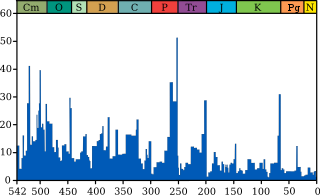
Back انقراض الكابتاني Arabic Extinction du Capitanien French Extinción masiva do Capitaniano Galician Midden-Perm Extinctie Dutch Кептенське масове вимирання Ukrainian
The Capitanian mass extinction event, also known as the end-Guadalupian extinction event,[2] the Guadalupian-Lopingian boundary mass extinction,[3] the pre-Lopingian crisis,[4] or the Middle Permian extinction, was an extinction event that predated the end-Permian extinction event. The mass extinction occurred during a period of decreased species richness and increased extinction rates near the end of the Middle Permian, also known as the Guadalupian epoch. It is often called the end-Guadalupian extinction event because of its initial recognition between the Guadalupian and Lopingian series; however, more refined stratigraphic study suggests that extinction peaks in many taxonomic groups occurred within the Guadalupian, in the latter half of the Capitanian age.[5] The extinction event has been argued to have begun around 262 million years ago with the Late Guadalupian crisis, though its most intense pulse occurred 259 million years ago in what is known as the Guadalupian-Lopingian boundary event.[6]
Having historically been considered as part of the end-Permian extinction event, and only viewed as separate relatively recently,[when?][7] this mass extinction is believed to be the third largest of the Phanerozoic in terms of the percentage of species lost, after the end-Permian and Late Ordovician mass extinctions, respectively,[8] while being the fifth worst in terms of ecological severity.[9] The global nature of the Capitanian mass extinction has been called into question by some palaeontologists as a result of some analyses finding it to have affected only low-latitude taxa in the Northern Hemisphere.[10]
- ^ Rohde, R.A. & Muller, R.A. (2005). "Cycles in fossil diversity". Nature. 434 (7030): 209–210. Bibcode:2005Natur.434..208R. doi:10.1038/nature03339. PMID 15758998. S2CID 32520208.
- ^ De la Horra, R.; Galán-Abellán, A. B.; López-Gómez, José; Sheldon, Nathan D.; Barrenechea, J. F.; Luque, F. J.; Arche, A.; Benito, M. I. (August–September 2012). "Paleoecological and paleoenvironmental changes during the continental Middle–Late Permian transition at the SE Iberian Ranges, Spain". Global and Planetary Change. 94–95: 46–61. Bibcode:2012GPC....94...46D. doi:10.1016/j.gloplacha.2012.06.008. Retrieved 15 December 2022.
- ^ Cite error: The named reference
HuangEtAl2019PPPwas invoked but never defined (see the help page). - ^ Shen, Shu-Zhong; Shi, G. R. (September 2009). "Latest Guadalupian brachiopods from the Guadalupian/Lopingian boundary GSSP section at Penglaitan in Laibin, Guangxi, South China and implications for the timing of the pre-Lopingian crisis". Palaeoworld. 18 (2–3): 152–161. doi:10.1016/j.palwor.2009.04.010. Retrieved 21 December 2022.
- ^ Bond, D. P. G., Wignall, P. B., Wang, W., Izon, G., Jiang, H. S., Lai, X. L., Sund, Y.-D., Newtona, R.J., Shaoe, L.-Y., Védrinea, S. & Cope, H. (2010). "The mid-Capitanian (Middle Permian) mass extinction and carbon isotope record of South China". Palaeogeography, Palaeoclimatology, Palaeoecology, 292 (1-2), pp. 282-294. https://dx.doi.org/10.1016/j.palaeo.2010.03.056
- ^ Kaiho, Kunio (22 July 2022). "Relationship between extinction magnitude and climate change during major marine and terrestrial animal crises". Biogeosciences. 19 (14): 3369–3380. Bibcode:2022BGeo...19.3369K. doi:10.5194/bg-19-3369-2022. Retrieved 18 March 2023.
- ^ Rampino, Michael R.; Shen, Shu-Zhong (5 September 2019). "The end-Guadalupian (259.8 Ma) biodiversity crisis: the sixth major mass extinction?". Historical Biology. 33 (5): 716–722. doi:10.1080/08912963.2019.1658096. S2CID 202858078. Retrieved 26 December 2022.
- ^ Isozaki, Yukio; Servais, Thomas (8 December 2017). "The Hirnantian (Late Ordovician) and end-Guadalupian (Middle Permian) mass-extinction events compared". Lethaia. 51 (2): 173–186. doi:10.1111/let.12252. Retrieved 23 October 2022.
- ^ McGhee Jr., George R.; Clapham, Matthew E.; Sheehan, Peter M.; Bottjer, David J.; Droser, Mary L. (15 January 2013). "A new ecological-severity ranking of major Phanerozoic biodiversity crises". Palaeogeography, Palaeoclimatology, Palaeoecology. 370: 260–270. Bibcode:2013PPP...370..260M. doi:10.1016/j.palaeo.2012.12.019. Retrieved 2 December 2022.
- ^ Metcalfe, I.; Crowley, J. L.; Nicholl, R. S.; Schmitz, M. (August 2015). "High-precision U-Pb CA-TIMS calibration of Middle Permian to Lower Triassic sequences, mass extinction and extreme climate-change in eastern Australian Gondwana". Gondwana Research. 28 (1): 61–81. Bibcode:2015GondR..28...61M. doi:10.1016/j.gr.2014.09.002. Retrieved 22 December 2022.
